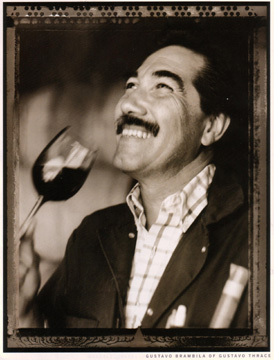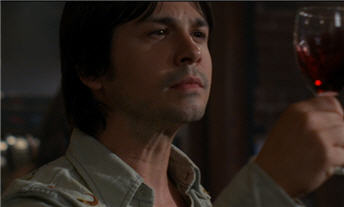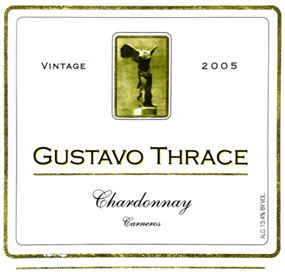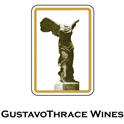

Notice: This is not an actor. This is the real Gustavo Brambila who did not make the award winning wine. (Mike Grgich did.) Today Brambila is co-owner of GustavoThrace Winery in Napa.
Bottle Shocked:
Uncorking the Real Gustavo Brambila
What's the difference between real life and the way Hollywood sees it? With the feature "Bottle Shock", quite a bit.
by
Alan Goldfarb
August 27, 2008
 onetheless Freddy Rodriguez, the actor in “Bottle Shock”, who portrays Gustavo Brambila, serendipitously uttered what was in the mind of the actual man. I tracked down the real Gustavo Brambila one recent afternoon where he was filtering wine for his GustavoThrace Winery, and it became evident that the winemaker has his roots deep in the Napa Valley soil.
onetheless Freddy Rodriguez, the actor in “Bottle Shock”, who portrays Gustavo Brambila, serendipitously uttered what was in the mind of the actual man. I tracked down the real Gustavo Brambila one recent afternoon where he was filtering wine for his GustavoThrace Winery, and it became evident that the winemaker has his roots deep in the Napa Valley soil.
 He acknowledged that he never lectured Chateau Montelena’s owners, the Barretts, about how one must live in the soil in order to make great wine. After all, his humble job was to work in the lab and to monitor quality control. But the notion of immersing oneself in the earth is precisely Brambila’s philosophy.
He acknowledged that he never lectured Chateau Montelena’s owners, the Barretts, about how one must live in the soil in order to make great wine. After all, his humble job was to work in the lab and to monitor quality control. But the notion of immersing oneself in the earth is precisely Brambila’s philosophy.
“It is true. You grow up in a region and you observe the microclimates and degree days and you see how much moisture there is, and how much dust is around the area, and what kind of organic matter is growing,” he told APPELLATION AMERICA “No, I did not (say those things that were uttered in the movie) but I was just as passionate as Freddy portrayed me. It was a passion of patience and doing it right the first time and taking what was valuable from the soils and how the grapes reacted to that.”
Brambila, now 55, was born in Jalisco, Mexico and came to the Napa Valley with his family when he was 3. His father worked for Beaulieu and Mike Grgich. It was through that connection that Grgich hired Brambila at Montelena in 1976, where he worked for only one year.
He arrived three years after Grgich made the epic 1973 Chardonnay (whose grapes incidentally, not only came from the Montelena estate but also from the Bacigalupi Vineyard in Sonoma County). And he “just missed” Steven Spurrier, who organized the tasting, and who came by Montelena one day in hopes of buying the wine.
The Hollywoodization of Napa Valley
Brambila, who almost didn’t participate in the film, which in true Hollywood fashion took great license and embellishment with the actual facts in the final analysis, is just “OK” with “Bottle Shock”. Although it’s bringing him unexpected notice, he’s dismayed that Grgich was never mentioned in the movie.
Gustavo Brambila as played by actor Freddy Rodriquez in “Bottle Shock.”
The filmmakers, who do not list a technical advisor (Grgich apparently has that position on a parallel production), apparently listened to some of Brambila’s concerns before he agreed to become part of the project.
“I had time to reflect with what they spoke about and had an opportunity to inject some of our feelings and opinions. They had a meeting and spoke of our concerns and made some changes.”
One of his chief problems was that as a Latino, he wanted to be treated with respect. “My main concern, being a Hispanic, was that I would be portrayed as a hot head to someone who would call me not by my name, and be portrayed as a stereotype, who was headstrong and macho,” he explained. In the film, of course, there is a scene in which Brambila is called out by a trucker, who makes racial epithets at him. But it was the young and very blond Bo Barrett who came to his friend’s defense, and thus was portrayed as the hot head.
“I was OK with it,” he said, “but I would have preferred that a little more time in the movie would tie in some of the other vintners, who were part of that tasting.”
Thus, in the end he said, “He (Grgich) had a point. We were passionate about what we were doing. It (the film) didn’t really illustrate how passionate we were about making wine. I thought we could have (been involved) a little more in the process so we could illustrate that it doesn’t stop in the vineyard.”
Moving Ahead with GustavoThrace
Nor has Brambila’s career stopped. At GustavoThrace, which he co-founded in 1996 and for which he makes about 7,000 cases a year, he manages and farms much of the fruit. Those vineyards are in the Coombsville area east of Napa, Rutherford, Carneros, Russian River Valley, Suisun, and Lodi.“Our wines are bright, fruity, and alive. That’s what these regions are all about,” he explained. “We enjoy making wines that have a certain structure, with acidity.
 We can do some Chardonnay (from the Ceja Vineyard in the Carneros) that has good acid and have it crisp and make it taste as if it’s gone through malolactic fermentation.”
We can do some Chardonnay (from the Ceja Vineyard in the Carneros) that has good acid and have it crisp and make it taste as if it’s gone through malolactic fermentation.”
He gets Cabernet and Merlot from Coombsville, which is cool and “has a microclimate that maintains steady heat and night cooling. Morning fog is not unusual. It’s like the old days in the Napa Valley with deep, rich, soft, balanced tannins.”
He sources Sauvignon Blanc from Lodi, which he explained as a “Curious one because it allows us to harvest at 21.5 (Brix) and still have mature flavors because of the way these people (Mohr Frey) farm it. They are able to manage it so that the balance of fruit to the vine is the key, and they are able to maintain green fruit during hot periods in Lodi.”
He also sources from Suisun, which Brambila explained has rich soil in which his Petite Sirah can survive because it has deep root structures. It is dry farmed with small, concentrated berries, and is bright and dark with balanced tannins.
The Pinot Noir from the Russian River Valley is a place that he’s “still learning.” It has minerals in the soil and its locale is breezy and has various elevations, and is all on Dijon clones. “I get to have a mixture of dark and light balanced flavors, aromas, and tannins,” he said.
In addition to his own brand, Brambila consults for a trio of Stags Leap District projects - J. Moss, Taylor Family, and Bartaloti. “I always knew the fruit (from SLD) was awesome and ... hardly available. What they say about that area is no stretch of the imagination. It’s good fruit.”
Oh, one other inaccuracy: The film makes a big deal about Brambila making his own red wine on the side, something which caused Jim Barrett to fire him. It never happened. Big shock, right?
 He did cop to the fact that he was making Chardonnay in his bathtub in stainless steel kegs, using the water as an ice bath. But he did think that Barrett had a point (in the film) that because of it,
He did cop to the fact that he was making Chardonnay in his bathtub in stainless steel kegs, using the water as an ice bath. But he did think that Barrett had a point (in the film) that because of it,










 READER FEEDBACK: To post your comments on this story,
READER FEEDBACK: To post your comments on this story,



